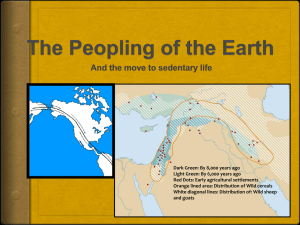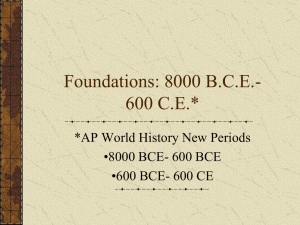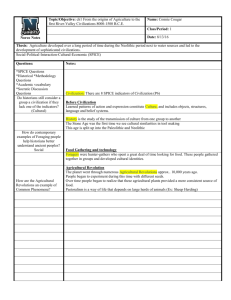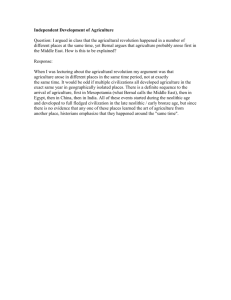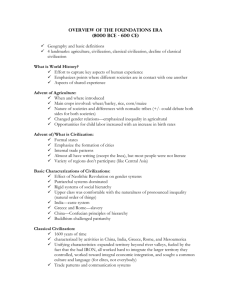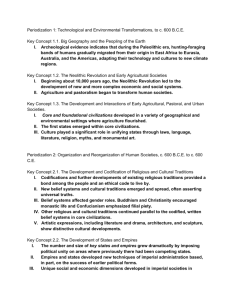Foundations
advertisement
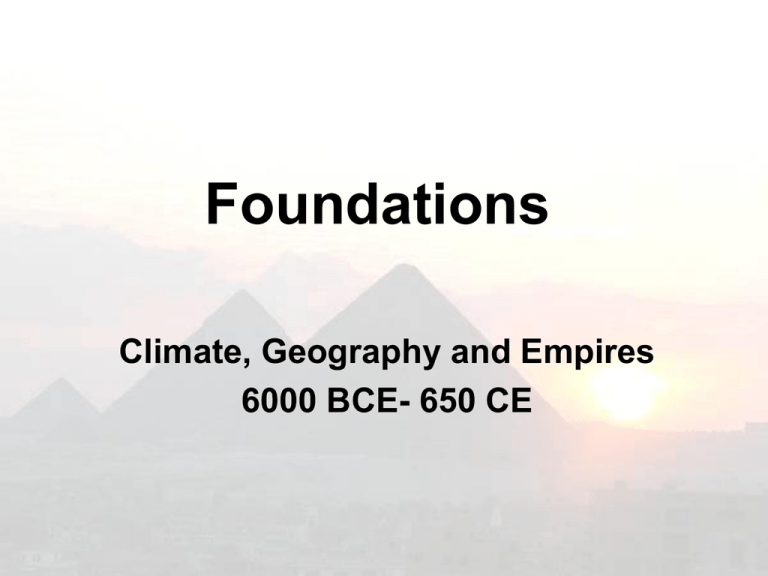
Foundations Climate, Geography and Empires 6000 BCE- 650 CE Big Geography & the Peopling of the Earth Neolithic Overview: A. Early migrations (Discover Magazine 5/20/08) B. Agricultural Revolution –and the resulting communities that develop C. Climate changes D. Tools E. Religion F. Limited Trade Neolithic Age? The Neolithic or New Stone Age (roughly 8000-3500BCE) is characterized by the movement away from a hunter-gatherer, nomadic lifestyle towards an agricultural lifestyle. During this time period we see the origins of farming and domestication of animals, which is often referred to as the Neolithic Revolution (though agricultural revolution may be more appropriate). These innovations produced the food surpluses and rising populations that made possible the founding of cities and the increasing specialization of occupations within human societies. Soon after the introduction of agriculture, societies in the Middle East began replacing stone tools with those made of metal—first copper, then bronze. These new tools improved agriculture, aided in warfare, and benefited manufacturing artisans. Early Migration A. Who? B. Why? The Fertile Crescent and the Birth of Farming Dark Green: By 8,000 years ago Light Green: By 6,000 years ago Red Dots: Early agricultural settlements Orange lined area: Distribution of Wild cereals White diagonal lines: Distribution of: Wild sheep and goats Civilization A. Origins of the term: B. Standard Criteria? C. Problems? Historians and anthropologist have noted several problems with the term civilization. First of all, it tends to be used in an ethnocentric way; in other words, it is used to assign to others an inferior status. For example, the Chinese of the Han dynasty thought all others in the world were uncivil barbarians; likewise, from the Spartans to Nazi Germany, designating others as less than civilized was often a pretense for conquering or destroying them. Secondly, the term marginalizes (excludes) other people who have made important contributions to history. For example, nomadic people are responsible for the diffusion of some of the most important technologies in history, but most accepted forms of the term civilization exclude them. From ancient times up to today, some peoples have seen themselves as “civilized” and dismissed or criticized their neighbors, or any people unfamiliar to them, as barbarians.” Another problem is that modern historians may focus too much on societies such as Egypt, that left more of an archaeological and written record, giving lesser attention to those societies that did not… the term is too subjective to have much value in understanding world history, and many historians refuse to use it altogether. It is not used in this text. Craig A. Lockard, Societies, Networks, and Transitions: A Global History, pg. 26 Impact of Agricultural Societies on Environment A. B. C. D. Irrigation Salinization of soil Slash and burn desertification Population increase Urbanization Impact of Agricultural Society on social interaction and social stratification A. B. C. D. E. Increased labor specialization Increased work-load!!! Especially for children! Increased conflict over resources, labor, and luxury items with new technologies Social stratification (socio-economic classes develop) “Civilization” with urban areas, specialized institutions, military, religious, social and political hierarchies, long distance trade, economic (as well as ideas, inventions and germs) exchanges between local and regional, as well as nomadic pastoralists and settled peoples. Impact of Agricultural Society on Gender Roles A. How might gender roles change as people stop their nomadic lifestyles and become horticulturalists? 1) 2) Early Neolithic horticulturalists: shared responsibility women farmed with the help of her children, men hunted, then helped at home. With population growth and expansion, military became more important and women increasingly were viewed by society as inferior. a) b) c) goddesses lost out to gods Family line through the father (patrilineal) instead of through the mother (matrilineal) Patriarchy in early societies(Code of Hammurabi) Population A. Demography: The study of population size, growth and age structure, and of the forces (fertility, mortality, migration) that lead to population change. B. What factors may influence population growth and decline? Climate and Geography A. Imagine how early societies may have been affected. B. How do you think early peoples responded? C. What difference would geography make in the long term development of a society? Development of States and Empires A. Competition for resources B. Expansion C. State legitimacy including unity building measures D. Military growth Emergence of Trans-regional Networks of Communication and Change A. Increase of long distance trade amongst large scale empires B. Raw materials and luxury goods C. Exchanges of technology, religious and cultural beliefs, food crops, domesticated animals and disease Early Societies A. B. C. D. E. Mesopotamia Egypt Indus Shang Mesoamerica and Andean South America (Olmec and Chavin) Civilizations: A Comparative Study (Kevin Reilly: Cities and Civilization) A. Mesopotamia 1) Irregular flooding A. Egypt 1) Predictable flood Axial Age Thinkers Origins of World Belief Systems A. Polytheism Origins of World Belief Systems A. Hinduism Origins of World Belief Systems A. Judaism Origins of World Belief Systems A. Confucianism Origins of World Belief Systems A. Daoism Origins of World Belief Systems A. Buddhism Origins of World Belief Systems A. Christianity Diffusion of Belief Systems Empire Building A. What does an empire require? B. What do its subjects expect? C. Symbols of legitimacy Empires: A Comparison A. Rome A. Han Fall of Empires: “Catastrophe” A. Why? B. Do we see commonalities? Or do different empires fall for different reasons? Imperial Achievements Alexander the Great Interregional Networks of People by 600 C.E. A. Silk Roads B. Mediterranean trade C. Indian Ocean trade Silk Routes Mediterranean Trade Routes Indian Ocean Trade
